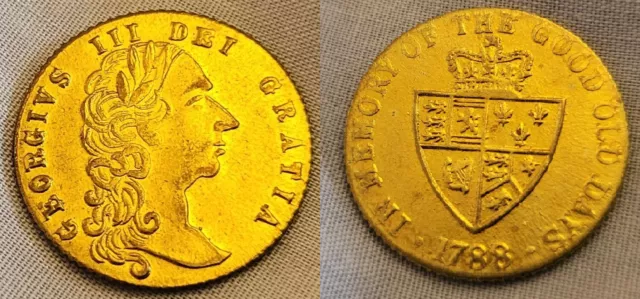1788 English Coin King George III Vintage Old Milled Royal Gold Lustre Antique
£19.99 Buy It Now or Best Offer, £2.49 Shipping, 30-Day Returns, eBay Money Back Guarantee
Seller:  checkoutmyunqiuefunitems ✉️ (3,792) 99.9%,
Location: Manchester, Take a look at my other items, GB,
Ships to: WORLDWIDE,
Item: 276378096805
1788 English Coin King George III Vintage Old Milled Royal Gold Lustre Antique. Vintage Coin 1788 George III Old Token Coin This is a victorian gaming token circa 1888 It is made of brass with a golden lustre One side has an image of King George III with the words "George III DEI GRATIA" The other side has a shield and the words "In Memory of the Good old days 1788" It is 22 mm in Diameter and it weighs 2 grams In Very Good Condition for its age Would make an Excellent Gift or Collectable Keepsake souvineer I have a lot more Old Coins So Please Check out my other items
checkoutmyunqiuefunitems ✉️ (3,792) 99.9%,
Location: Manchester, Take a look at my other items, GB,
Ships to: WORLDWIDE,
Item: 276378096805
1788 English Coin King George III Vintage Old Milled Royal Gold Lustre Antique. Vintage Coin 1788 George III Old Token Coin This is a victorian gaming token circa 1888 It is made of brass with a golden lustre One side has an image of King George III with the words "George III DEI GRATIA" The other side has a shield and the words "In Memory of the Good old days 1788" It is 22 mm in Diameter and it weighs 2 grams In Very Good Condition for its age Would make an Excellent Gift or Collectable Keepsake souvineer I have a lot more Old Coins So Please Check out my other items
Coins are pieces of hard material used primarily as a medium of exchange or legal tender. They are standardized in weight, and produced in large quantities at a mint in order to facilitate trade. They are most often issued by a government. Coins are usually metal or alloy metal, or sometimes made of synthetic materials. They are usually disc shaped. Coins made of valuable metal are stored in large quantities as bullion coins. Other coins are used as money in everyday transactions, circulating alongside banknotes: these coins are usually worth less than banknotes: usually the highest value coin in circulation (i.e. excluding bullion coins) is worth less than the lowest-value note. In the last hundred years, the face value of circulation coins has occasionally been lower than the value of the metal they contain, for example due to inflation. If the difference becomes significant, the issuing authority may decide to withdraw these coins from circulation, or the general public may decide to melt the coins down or hoard them (see Gresham's law). Exceptions to the rule of face value being higher than content value also occur for some bullion coins made of silver or gold (and, rarely, other metals, such as platinum or palladium), intended for collectors or investors in precious metals. Examples of modern gold collector/investor coins include the British sovereign minted by the United Kingdom, the American Gold Eagle minted by the United States, the Canadian Gold Maple Leaf minted by Canada, and the Krugerrand, minted by South Africa. The American Gold Eagle has a face value of US$50, and the Canadian Gold Maple Leaf coins also have nominal (purely symbolic) face values (e.g. C$50 for 1 oz.); but the Krugerrand does not. Historically, a great quantity of coinage metals (including alloys) and other materials (e.g. porcelain) have been used to produce coins for circulation, collection, and metal investment: bullion coins often serve as more convenient stores of assured metal quantity and purity than other bullion.[1] Today, the term coin can also be used in reference to digital currencies which are not issued by a state. As of 2013, examples include BitCoin and LiteCoin, among others. As coins have long been used as money, in some languages the same word is used for "coin" and "currency". Numismatics Claudius II coin (colourised).png Currency Coins · Banknotes · Forgery Community currencies Company scrip · Coal scrip · LETS · Time dollars Fictional currencies History Ancient currencies Greek · Roman · China · India Byzantine Medieval currencies Modern currencies Africa · The Americas · Europe · Asia · Oceania Production Mint · Designers · Coining · Milling · Hammering · Cast Exonumia Credit cards · Medals · Tokens · Cheques Notaphily Banknotes Scripophily Stocks · Bonds The first coins were developed independently in Iron Age Anatolia and Archaic Greece, India & China around 600-700 BC. Coins spread rapidly in the 6th and 5th centuries BC, throughout Greece and Persia, and further to the Balkans.[2] Standardized Roman currency was used throughout the Roman Empire. Important Roman gold and silver coins were continued into the Middle Ages (see Gold dinar, Solidus, Aureus, Denarius). Ancient and early medieval coins in theory had the value of their metal content, although there have been many instances throughout history of the metal content of coins being debased, so that the inferior coins were worth less in metal than their face value. Fiat money first arose in medieval China, with the jiaozi paper money. Early paper money was introduced in Europe in the later Middle Ages, but some coins continued to have the value of the gold or silver they contained throughout the Early Modern period. The penny was mint (coin)ed as a silver coin until the 17th century. The first copper pennies were minted in the United States in the 1790s.[3][citation needed] Silver content was reduced in many coins in the 19th century (use of billon), and the first coins made entirely of base metal (e.g. nickel, cupronickel, aluminium bronze), representing values higher than the value of their metal, were minted in the mid 19th century. Bronze Age predecessors[edit] An Oxhide ingot from Crete. Late Bronze Age metal ingots were given standard shapes, such as the shape of an "ox-hide", suggesting that they represented standardized values. Coins were an evolution of "currency" systems of the Late Bronze Age, where standard-sized ingots, and tokens such as knife money, were used to store and transfer value. In the late Chinese Bronze Age, standardized cast tokens were made, such as those discovered in a tomb near Anyang.[4][5] These were replicas in bronze of earlier Chinese money, cowrie shells, so they were named Bronze Shell.[6][7][8] These, as well as later Chinese bronzes, were replicas of knives, spades, and hoes, but not "coins" in the narrow sense, as they did not carry a mark or marks certifying them to be of a definite exchange value.[9] Iron Age[edit] Further information: Archaic period of ancient Greek coinage 1/3rd stater from Lydia, 6th century BC. Electrum coin from Ephesus, 620-600 BC. Obverse: Forepart of stag. Reverse: Square incuse punch. Anatolian gold coin from 4th century BC Mysia. Greek drachma of Aegina. Obverse: Land Chelone / Reverse: ΑΙΓ(INA) and dolphin. The oldest Aegina Chelone coins depicted sea turtles and were minted ca. 700 BC.[10] The earliest coins are mostly associated with Iron Age Anatolia, especially with the kingdom of Lydia.[11] Early electrum coins were not standardized in weight, and in their earliest stage may have been ritual objects, such as badges or medals, issued by priests.[12] Many early Lydian and Greek coins were minted under the authority of private individuals and are thus more akin to tokens or badges than to modern coins,[13] though due to their numbers it is evident that some were official state issues, with King Alyattes of Lydia being a frequently mentioned originator of coinage.[14] The first Lydian coins were made of electrum, a naturally occurring alloy of silver and gold that was further alloyed with added silver and copper.[15] Most of the early Lydian coins include no writing ("legend" or "inscription"), only an image of a symbolic animal. Therefore the dating of these coins relies primarily on archaeological evidence, with the most commonly cited evidence coming from excavations at the Temple of Artemis at Ephesus, also called the Ephesian Artemision (which would later evolve into one of the Seven Wonders of the Ancient World). Because the oldest lion head "coins" were discovered in that temple, and they do not appear to have been used in commerce, these objects may not have been coins but badges or medals issued by the priests of that temple. Anatolian Artemis was the Πὀτνια Θηρῶν (Potnia Thêrôn, "Mistress of Animals"), whose symbol was the stag. A small percentage of early Lydian/Greek coins have a legend.[16] A famous early electrum coin, the most ancient inscribed coin at present known, is from nearby Caria. This coin has a Greek legend reading phaenos emi sema [17] interpreted variously as "I am the badge of Phanes", or "I am the sign of light",[18] or "I am the tomb of light", or "I am the tomb of Phanes". The coins of Phanes are known to be amongst the earliest of Greek coins, a hemihekte of the issue was found in the foundation deposit of the temple of Artemis at Ephesos (the oldest deposit of electrum coins discovered). One assumption is that Phanes was a wealthy merchant, another that this coin is associated with Apollo-Phanes and, due to the Deer, with Artemis (twin sister of the god of light Apollo-Phaneos). Although only seven Phanes type coins were discovered, it is also notable that 20% of all early electrum coins also have the lion of Artemis and the sun burst of Apollo-Phaneos. Alternatively, Phanes may have been the Halicarnassian mercenary of Amasis mentioned by Herodotus, who escaped to the court of Cambyses, and became his guide in the invasion of Egypt in 527 or 525 BC. According to Herodotus, this Phanes was buried alive by a sandstorm, together with 50,000 Persian soldiers, while trying to conquer the temple of Amun–Zeus in Egypt.[19] The fact that the Greek word "Phanes" also means light (or lamp), and the word "sema" also means tomb makes this coin a famous and controversial one.[20] Another candidate for the site of the earliest coins is Aegina, where Chelone ("turtle") coins were first minted on 700 BC,[21] either by the local Aegina people or by Pheidon king of Argos (who first set the standards of weights and measures). In the Bibliothèque Nationale, Paris, there is a unique electrum stater of Aegina.[10][22][unreliable source?] Coins from Athens and Corinth appeared shortly thereafter, known to exist at least since the late 6th century BC.[23] Classical Antiquity[edit] Further information: Ancient Greek coinage, Achaemenid coinage, Illyrian coinage, Roman currency, Coinage of India, Aureus, Solidus (coin), Denarius, and Antoninianus Set of three roman aurei depicting the rulers of the Flavian dynasty. Top to bottom: Vespasian, Titus and Domitian. 69-96 AD. Coinage followed Greek colonization and influence first around the Mediterranean and soon after to North Africa (including Egypt), Syria, Persia, and the Balkans.[24] Coins were minted in the Achaemenid Empire, including the gold darics and silver sigloi. and with the Achemenid conquest of Gandhara under Darius the Great ca. 520 BC, the practice spread to the Indo-Gangetic Plain. The coins of this period were called Puranas, Karshapanas or Pana.[25] These earliest Indian coins, however, are unlike those circulated in Persia, which were derived from the Greek/Anatolian type; they not disk-shaped but rather stamped bars of metal, suggesting that the innovation of stamped currency was added to a pre-existing form of token currency which had already been present in the Mahajanapada kingdoms of the Indian Iron Age. Mahajanapadas that minted their own coins included Gandhara, Kuntala, Kuru, Panchala, Shakya, Surasena and Surashtra.[26] In China, early round coins appear in the 4th century BC. The first Roman coins, which were crude, heavy cast bronzes, were issued ca. 289 B Most coins presently are made of a base metal, and their value comes from their status as fiat money. This means that the value of the coin is decreed by government fiat (law), and thus is determined by the free market only inasmuch as national currencies are used in domestic trade and also traded internationally on foreign exchange markets. Thus these coins are monetary tokens, just as paper currency is: they are usually not backed by metal, but rather by some form of government guarantee. Some have suggested that such coins not be considered to be "true coins" (see below). Thus there is very little economic difference between notes and coins of equivalent face value. Coins may be in circulation with fiat values lower than the value of their component metals, but they are never initially issued with such value, and the shortfall only arises over time due to inflation, as market values for the metal overtake the fiat declared face value of the coin. Examples are the pre-1965 US dime, quarter, half dollar, and dollar, US nickel, and pre-1982 US penny. As a result of the increase in the value of copper, the United States greatly reduced the amount of copper in each penny. Since mid-1982, United States pennies are made of 97.5% zinc, with the remaining 2.5% being a coating of copper. Extreme differences between fiat values and metal values of coins causes coins to be hoarded or removed from circulation by illicit smelters in order to realise the value of their metal content. This is an example of Gresham's law. The United States Mint, in an attempt to avoid this, implemented new interim rules on December 14, 2006, subject to public comment for 30 days, which criminalized the melting and export of pennies and nickels.[30] Violators can be fined up to $10,000 and/or imprisoned for up to five years. A coin's value as a collector's item or as an investment generally depends on its condition, specific historical significance, rarity, quality/beauty of the design and general popularity with collectors. If a coin is greatly lacking in all of these, it is unlikely to be worth much. The value of bullion coins is also influenced to some extent by those factors, but is largely based on the value of their gold, silver, or platinum content. Sometimes non-monetized bullion coins such as the Canadian Maple Leaf and the American Gold Eagle are minted with nominal face values less than the value of the metal in them, but as such coins are never intended for circulation, these face values have no relevance. Coins can be used as creative medium of expression – from fine art sculpture to the penny machines that can be found in most amusement parks. In the Code of Federal Regulations (CFR) in the United States there are some regulations specific to nickels and pennies that are informative on this topic. 31 CFR § 82.1 foroffers unauthorized persons from exporting, melting, or treating any 5 or 1 cent coins. This has been a particular problem with nickels and dimes (and with some comparable coins in other currencies) because of their relatively low face value and unstable commodity prices. For a while the copper in US pennies was worth more than one cent, so people would hoard pennies then melt them down for their metal value. It costs more than face value to manufacture pennies or nickels, so any widespread loss of the coins in circulation could be expensive for the Treasury. This was more of a problem when coins were still made of precious metals like silver and gold, so historically strict laws against alteration make more sense. 31 CFR § 82.2 goes on to state that: "(b) The prohibition contained in § 82.1 against the treatment of 5-cent coins and one-cent coins shall not apply to the treatment of these coins for educational, amusement, novelty, jewelry, and similar purposes as long as the volumes treated and the nature of the treatment makes it clear that such treatment is not intended as a means by which to profit solely from the value of the metal content of the coins." Ancient Rome was an Italic civilization that began on the Italian Peninsula as early as the 8th century BC. Located along the Mediterranean Sea and centered on the city of Rome, it expanded to become one of the largest empires in the ancient world[1] with an estimated 50 to 90 million inhabitants (roughly 20% of the world's population[2][3][4]) and covering 6.5 million square kilometers (2.5 million sq mi) during its height between the first and second centuries AD.[5][6][7] In its approximately 12 centuries of existence, Roman civilization shifted from a monarchy to a classical republic to an increasingly autocratic empire. Through conquest and assimilation, it came to dominate Southern Europe, Western Europe, Asia Minor, North Africa, parts of Northern Europe, and parts of Eastern Europe. Rome was preponderant throughout the Mediterranean region and was one of the most powerful entities of the ancient world. It is often grouped into "Classical Antiquity" together with ancient Greece, and their similar cultures and societies are known as the Greco-Roman world. The Romans are still remembered today, including names such as Julius Caesar, Cicero, and Augustus. Ancient Roman society contributed greatly to government, law, politics, engineering, art, literature, architecture, technology, warfare, religion, language, society and more in the Western world. A civilization highly developed for its time, Rome professionalized and greatly expanded its military and created a system of government called res publica, the inspiration for modern republics[8][9][10] such as the United States and France. It achieved impressive technological and architectural feats, such as the construction of an extensive system of aqueducts and roads, as well as large monuments, palaces, and public facilities. By the end of the Republic, Rome had conquered the lands around the Mediterranean and beyond: its domain extended from the Atlantic to Arabia and from the mouth of the Rhine to North Africa. The Roman Empire emerged under the leadership of Augustus Caesar. Under Trajan, the Empire reached its territorial peak. Republican mores and traditions started to decline during the imperial period, with civil wars becoming a common ritual for a new emperor's rise.[11][12][13] States, such as Palmyra, temporarily divided the Empire in a third-century crisis. Soldier emperors reunified it, by dividing the empire between Western and Eastern halves. Plagued by internal instability and attacked by various migrating peoples, the western part of the empire broke up into independent kingdoms in the 5th century. This splintering is a landmark historians use to divide the ancient period of universal history from the pre-mediaeval "Dark Ages" of Europe. The Eastern Roman Empire survived this crisis and was governed from Constantinople after the division of the Empire. It comprised Greece, the Balkans, Asia Minor, Syria and Egypt. Despite the later loss of Syria and Egypt to the Arab-Islamic Empire, the Eastern Roman Empire continued for another millennium, until its remnants were annexed by the emerging Turkish Ottoman Empire. This eastern, Christian, medieval stage of the Empire is usually called the Byzantine Samnite Wars · Pyrrhic War · Punic Wars (First, Second, Third) · Macedonian Wars (Illyrian · First Macedonian · Second Macedonian · Seleucid · Third Macedonian · Fourth Macedonian) · Jugurthine War · Cimbrian War · Roman Servile Wars (First · Second · Third) · Social War · Civil wars of Lucius Cornelius Sulla (First · Second) · Mithridatic Wars (First · Second · Third) · Gallic Wars · Julius Caesar's civil war · End of the Republic (Post-Caesarian · Liberators' · Sicilian · Fulvia's · Final) Wars of the Roman Empire Germanic Wars (Marcomannic · Alamannic · Gothic · Visigothic) · Wars in Britain · Wars of Boudica · Armenian War · Civil War of 69 · Jewish Wars · Domitian's Dacian War · Trajan's Dacian Wars · Parthian Wars · Roman–Persian Wars · Civil Wars of the Third Century · Wars of the Fall of the Western Roman Empire
|
- Condition: In Good Condition for its age
- Denomination: Unknown
- Year of Issue: 1788
- Era: Early Milled (c.1662-1816)
- Collections/ Bulk Lots: No
- Fineness: Unknown
- Country/Region of Manufacture: United Kingdom
- Modified Item: No
- Country of Origin: Great Britain
- Colour: Gold
PicClick Insights - 1788 English Coin King George III Vintage Old Milled Royal Gold Lustre Antique PicClick Exclusive
- Popularity - 11 watchers, 0.3 new watchers per day, 35 days for sale on eBay. Super high amount watching. 4 sold, 5 available.
- Best Price -
- Seller - 3,792+ items sold. 0.1% negative feedback. Top-Rated Plus! Top-Rated Seller, 30-day return policy, ships in 1 business day with tracking.
People Also Loved PicClick Exclusive

1788 Antique King George III Shield Coin Token Collectable 2cm Dia J4 O611
£5.95 1 Bid 2d 13h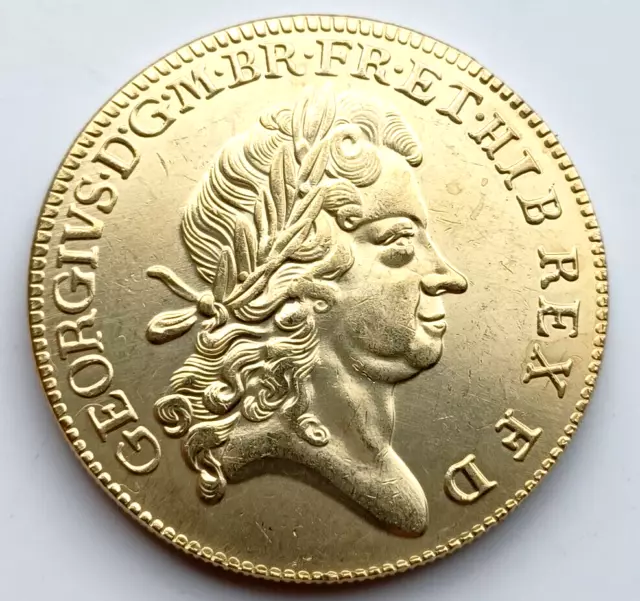
1716 George l Five Guineas, Beautifully Gold Plated, Original Size.
£4.50 Buy It Now 16d 4h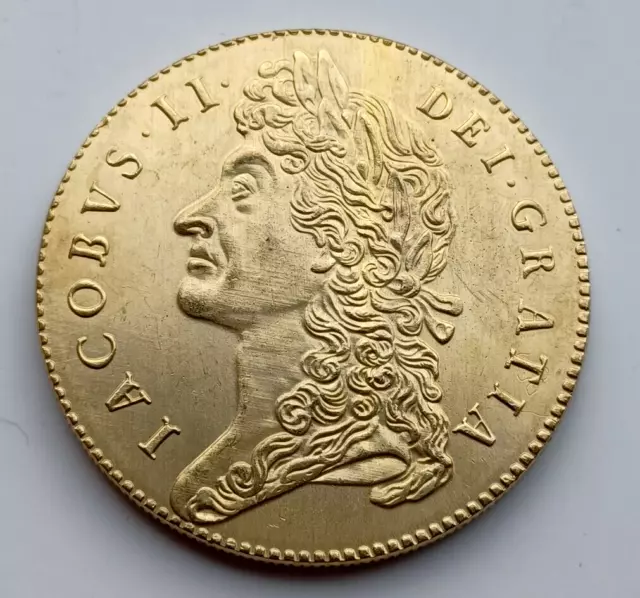
1688 James ll Five Guineas, Beautifully Gold Plated, Original Size.
£4.50 Buy It Now 16d 4h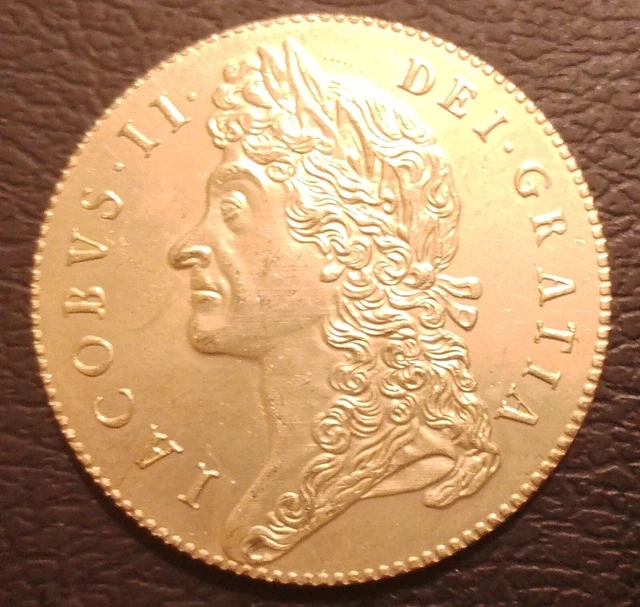
Retro James II 1688 Five Guineas. Souvenir Gap Filler. Same size as original.
£3.69 Buy It Now 7d 4h
Retro James II 1688 Five Guineas. Souvenir Gap Filler. Same size as original.
£3.69 Buy It Now 7d 4h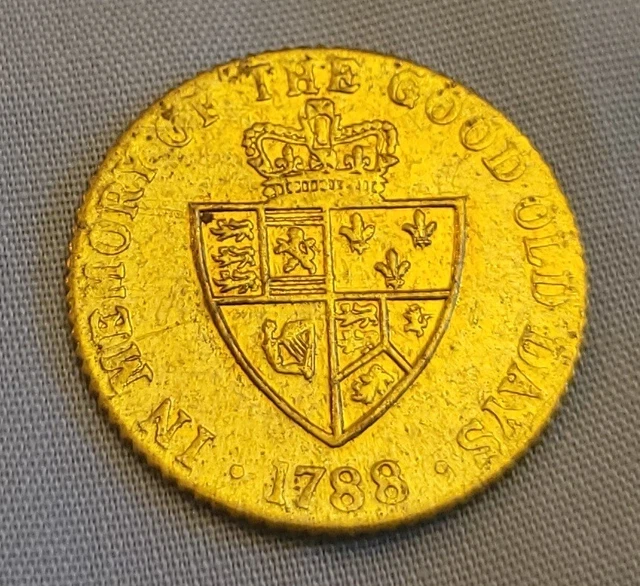 3 watchers
3 watchers1788 Old Coin English Gold Lustre King George III Vintage Royal Family Mint UK
£11.00 10 Bids 5d 15h
1797 King George III Cartwheel One Penny Coin Farthing 1p UK British English
£4.00 0 Bids 12h 4m
King Charles III 24K GOLD 50P COIN, PRECIOUS ENGLISH COIN GIFT,INVESTMENT GOLD
£49.98 Buy It Now 1 watcher
1 watcher1930 Farthing Coin - King George VI Old British English Antique Collectable
£1.20 Buy It Now
